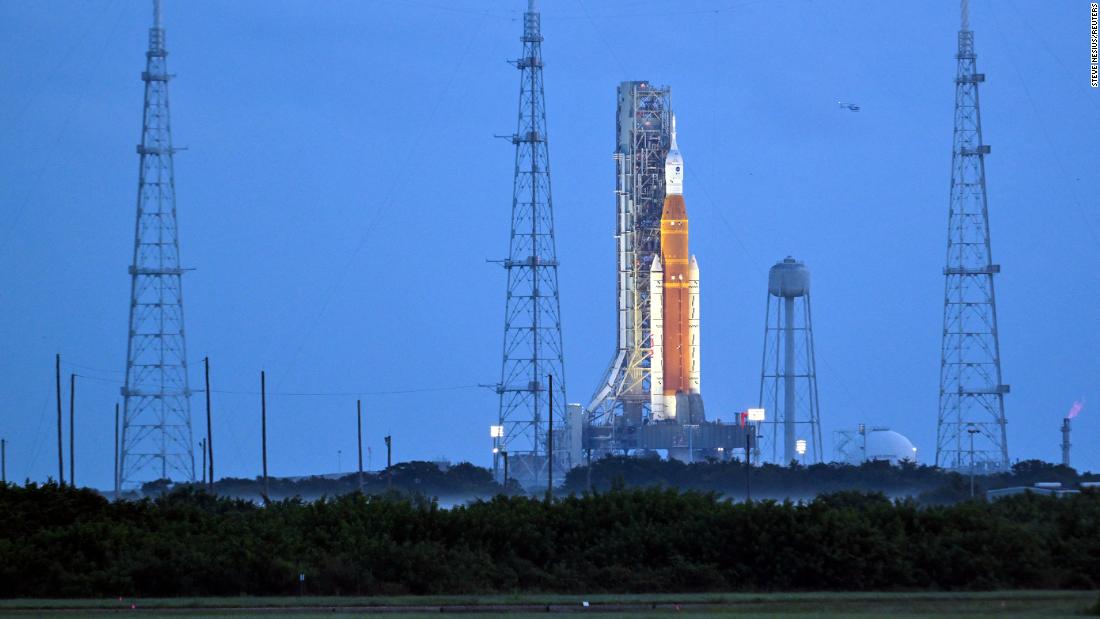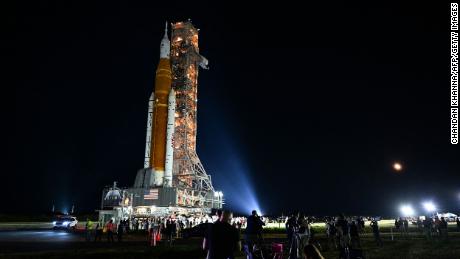Turn to CNN for live coverage from Kennedy Space Center in Florida on Saturday afternoon. Space correspondent Kristin Fisher will bring us moment-by-moment reporting from the launch, along with a team of experts.
Shortly before 5 a.m. ET, mission managers received a weather briefing and decided to proceed with loading propellant into the rocket. The countdown clock resumed at 7:07 a.m. ET.
There was a 30-minute delay after a liquid hydrogen leak was detected at 7:15 a.m. ET in the quick disconnect cavity that feeds the rocket with hydrogen in the engine section of the core stage. It was a different leak than one that occurred ahead of the scrubbed launch on Monday.
The launch controllers warmed up the line to get a tight seal and the flow of liquid hydrogen has resumed. Meanwhile, liquid oxygen continues to slowly flow into the core stage. Both propellants need to be filled within certain proportions to one another.
There is a 60% chance of favorable weather conditions for the launch, with chances increasing to 80% favorable toward the end of the window, according to weather officer Melody Lovin.
The Artemis I stack, which includes the Space Launch System rocket and Orion spacecraft, sits on Launchpad 39B at Kennedy Space Center in Cape Canaveral, Florida.
The Artemis I mission is just the beginning of a program that will aim to return humans to the moon and eventually land crewed missions on Mars.
If the mission launches on Saturday, it will go on a journey around the moon and splashdown in the Pacific Ocean on October 11. There is still a backup opportunity for the Artemis I mission to launch on September 5 as well.
In the last few days, the launch team has taken time to address issues, like hydrogen leaks, that cropped up ahead of Monday’s planned launch before it was scrubbed. The team has also completed a risk assessment of an engine conditioning issue and a foam crack that also cropped up, according to NASA officials.
Both are considered to be acceptable risks heading into the launch countdown, according to Mike Sarafin, Artemis mission manager.
On Monday, a sensor on one of the rocket’s four RS-25 engines, identified as engine #3, reflected that the engine could not reach the proper temperature range required for the engine to start at liftoff.
The engines need to be thermally conditioned before super-cold propellant flows through them before liftoff. To prevent the engines from experiencing any temperature shocks, launch controllers gradually increase the pressure of the core stage liquid hydrogen tank in the hours before launch to send a small amount of liquid hydrogen to the engines. This is known as a “bleed.”
The team has since determined it was a bad sensor providing the reading — they plan to ignore the faulty sensor moving forward, according to John Blevins, Space Launch Systems chief engineer.
The bleed, expected to occur around 8 a.m. ET, is currently on hold.
Mission overview
After Artemis I launches, Orion’s journey will last 37 days as it travels to the moon, loops around it and returns to Earth — traveling a total of 1.3 million miles (2.1 million kilometers).
While the passenger list doesn’t include any humans, it does have passengers: three mannequins and a plush Snoopy toy will ride in Orion.
Expect to see views of Earthrise similar to what was shared for the first time during the Apollo 8 mission back in 1968, but with much better cameras and technology.










More News
The Bleak Life of a Deposed President and His Wife, Held Captive
Frank Stella, Towering Artist and Master of Reinvention, Dies at 87
Hats on and Off at the 150th Kentucky Derby